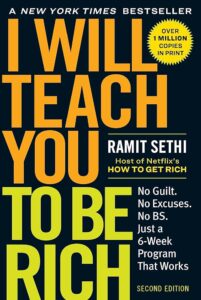
I Will Teach You to Be Rich: No Guilt. No Excuses. Just a 6-Week Program That Works (Second Edition)
Chapters 8 and 9: An Open Letter to New Readers
by DenzelleChapters 8 and 9 of Week Six: Action Steps offer readers a strategic guide for creating a financial system that supports a sustainable, fulfilling “Rich Life.” Chapter 8 opens with an important Open Letter reminding readers of the significance of consistency when building and maintaining a financial foundation. The chapter emphasizes practical steps such as investment rebalancing and tax planning, urging readers to adopt a long-term mindset. By advising a focus on a ten-year financial plan and ignoring the distractions of short-term financial “noise,” the chapter challenges readers to view wealth-building as a gradual process that aligns with their broader life goals.
Beyond the mechanics of financial growth, the chapter introduces a deeper purpose for wealth—philanthropy. The author links financial success not only to personal benefit but also to the broader impact one can have on their community. By integrating the idea of giving back, the chapter motivates readers to see wealth as a powerful tool for creating positive change. It encourages readers to focus on how their financial accomplishments can enrich their lives and those around them, making financial success a means of contributing to the greater good.
Moving into Chapter 9, the narrative shifts toward personal financial decisions and the challenges they bring. This chapter provides practical advice for key life milestones such as weddings, home-buying, and major purchases like cars. It offers clarity on topics that often cause confusion, such as managing wedding budgets, where the advice is to focus on what truly matters rather than getting caught up in societal expectations. The chapter also gives actionable tips on negotiating better deals on significant purchases, empowering readers to make smarter financial decisions without overburdening themselves.
Additionally, Chapter 9 addresses the complexities of managing personal finances in the context of relationships. It covers important but often uncomfortable topics such as how to balance paying off student loan debt with investing, supporting parents who are financially struggling, and handling financial discussions with a partner. The chapter also delves into discussions about prenuptial agreements and salary negotiations, giving readers the tools to navigate these potentially stressful areas with confidence. By offering clear guidance on these sensitive issues, the author equips readers to manage both the emotional and financial aspects of life’s challenges.
The updated edition of the book builds on previous insights, incorporating feedback and reflecting on earlier shortcomings. The author acknowledges mistakes such as failing to update interest rate information in past editions and underestimating the emotional complexity of financial decision-making. The new edition not only addresses these gaps but also includes fresh strategies that cater to the evolving financial landscape, making the advice more relevant and actionable for today’s readers.
The book encourages readers to personalize their financial goals, tailoring their plans to their individual values and circumstances. The new edition provides a flexible framework for readers, ensuring that they can create a financial system that works for their unique situation. By combining principles of philanthropy, thoughtful spending, and strategic planning, the chapters stress that a “Rich Life” is more than just financial success—it is about balance, purpose, and fulfillment.
Ultimately, Chapters 8 and 9 aim to empower readers to take charge of both their financial systems and life decisions. The consistent theme is the importance of aligning financial choices with personal values and long-term aspirations. By adopting a proactive approach and embracing generosity, readers are encouraged to build a sustainable foundation for long-term prosperity. The strategies presented in this updated edition provide readers with the tools they need to navigate modern financial complexities, helping them create the rich, meaningful life they aspire to.
These chapters inspire readers to look at financial success holistically—considering not just wealth but also well-being, personal growth, and meaningful relationships. The integrated advice on how to balance financial goals with life’s milestones serves as a reminder that prosperity comes not just from accumulation, but from creating a life of value, purpose, and joy.


0 Comments